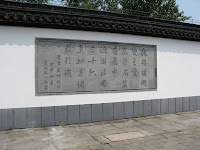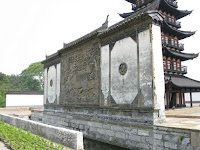

Entrance to this garden
It is one of the best-known pagodas south of the Yangtze River and follows the type of Buddhist square pagoda of Tang dynasty. Entrance ticket to this place is RMB12 per adult. Children are free admission.

Entrance ticket
There was a large rock with wording right in front of us when we entered the garden. Looking through the map, it seems that this garden is quite a large place.
Ancient tree of 400 years old
Garden surrounding near the entrance
Square Pagoda was built in 949 AD. Made of wood and bricks, the nine-story, 42.5-meter-high square pagoda features the architectural style of brink pagodas of the Tang Dynasty. Many parts of the building are original from the Song Dynasty. The pagoda today is surrounded by a "classical garden," which is dotted with bridges, pavilions and stone formations.The Square Pagoda
The walls surrounding this pagoda
To the north of the Square Pagoda is a brick screen wall that is 4.75 meters in width, 6.1 meters in length and 3 meters in thickness.. It was erected in 1370 (the 3rd year under reign of Hong Wu of the Ming Dynasty) and is the oldest and the best-preserved engraved brick work in Shanghai. On the wall there is a legendary creature named "Tan" which has deer antlers, dragon scale, lion tail, and ox hoofs and various paintings of auspicious implications. A legend says that this monster got drowned in the sea in an attempt to swallow the sun on the sea. The vivid brick sculptures on the wall are all precious art works.Legendary creature named "Tan"
This pagoda was completed in the 11th century under the Song dynasty, although it is in the style of the earlier Tang dynasty, marking the period in which construction began. Recently restored in its former elegance, over half of the original wood is still intact.The backside view of the Brick Screen Wall
Right at one end I have found a tea garden at some secluded spot. Have not gone in further after taking some photos.

Found a temple not far from the pagoda, in fact walking distance and can be seen from the pagoda grounds.
Seems that bell and drum is common in this area of SongJiang
We reached a place just after this temple that has olden walls made of large bricks. It is the sort of wall that I have seen at Osaka Castle when I last visited. Only thing different is that there are a lot of trees surrounding these walls. In the hot summer in Shanghai, shade like this is a welcomed sign and we spent quite some time hidden away in this sector of the garden. Mostly enjoying the green trees and cool shade.Family photo shot with the ancient walls
Covering an area of 17,273 square meters in Songjiang District, Shanghai, Fangta Garden was designed by Feng in 1978. The garden includes a nine-story wooden pagoda and a stone bridge from the Song dynasty, a grey brick wall from the Ming dynasty, two temples from the Qing dynasty, and also zigzag lanes, large lawns, a big square with several pavilions, and a teahouse designed by Feng. Fangta Garden has been acclaimed a masterpiece of Chinese urban design, combining traditional Chinese landscaping with modern urban design and planning.After walking for some time, we reached a building that is converted to a museum. There are some display of text, books, cannons and old stuffs within the building.


This part of the garden features some stone statues of horses, tortoise, some kind of cat like animal, warrior and wise "Confucius"-like oldman.
Short description of what these are...
Some kind of warriors - they are arrange symmetrically across each other













































































No comments:
Post a Comment